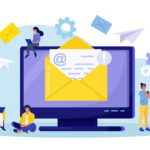Marketers often wonder why their email campaigns fail to capture attention. The answer is usually simple: relevance. Generic, one-size-fits-all emails rarely stand out in today’s overcrowded inboxes. This is where email segmentation excels, transforming generic messages into personalized experiences that resonate. In today’s article, we’ll discuss what email segmentation is and why it’s key to higher open rates.
What Is Email Segmentation?
Email segmentation is the practice of dividing your email list into smaller, more specific groups based on shared characteristics, behaviors, or preferences. Instead of treating all subscribers the same, segmentation allows you to send tailored messages to the right people at the right time.
For example, instead of sending a blanket promotion to your entire list, you can send a special discount to loyal customers while offering a first-purchase incentive to new subscribers. This personalization promotes engagement, builds trust, and, most importantly, boosts open rates.
Pro Tip: Segmentation and personalization go hand in hand. Learn how to maximize the impact of your segmented campaigns with The Power of Personalization in Email Marketing.
Why Segmentation Matters for Open Rates
Open rates are a critical metric for email marketers. They reflect the percentage of recipients who actually open your emails, offering a direct indicator of how well your campaigns are performing. Segmentation impacts open rates in several key ways:
- Relevance Captures Attention: Segmented emails are specifically tailored to meet your audience’s interests, making them instantly more appealing. For example, a fitness brand can target workout enthusiasts with equipment discounts while promoting nutrition plans to subscribers interested in healthy eating. This alignment between content and interest dramatically increases the likelihood of an open.
- Personalization Enhances Trust: Personalized emails make recipients feel valued. Including a subscriber’s name, referencing their recent interactions, or highlighting products they’ve browsed creates a sense of individual attention. This trust-building approach ensures higher engagement rates.
- Optimized Timing Maximizes Relevance: Timing is everything. Segmentation enables you to deliver emails when your audience is most likely to engage. Whether it’s sending promotional offers during seasonal sales or follow-ups after a product demo, hitting the right moment amplifies results. Deep dive: See The Best Times to Send Emails Based on Your Audience to optimize send times by segment for maximum engagement.
- Improved User Experience Reduces Unsubscribes: Irrelevant emails are a leading cause of unsubscribes. When segmentation ensures that every message is pertinent to the recipient’s needs or preferences, frustration levels drop, and loyalty grows. This creates a more satisfying experience and reduces churn.
- Higher Engagement Feeds Future Campaigns: Engaged subscribers who open and interact with your emails generate valuable data. This data can be used to further refine segmentation strategies, creating a feedback loop of continuous improvement and higher open rates.
Practical Email Segmentation Strategies for Higher Open Rates
If you’re ready to put segmentation into action, here are some practical strategies to implement:
1. Segment by Demographics
Basic demographic information like age, location, gender, or income level can provide a strong foundation for your segmentation strategy. For example:
- Age Groups: Tailor content to fit generational preferences, such as promoting trendy gadgets for younger audiences or wellness products for older demographics.
- Location: Share region-specific offers, announce local events, or adjust messaging based on cultural or seasonal factors.
2. Leverage Purchase History
Your subscribers’ past purchases are a goldmine of data. Here’s how to use it effectively:
- Complementary Products: Recommend items that pair well with previous purchases, like offering a phone case after a smartphone purchase.
- Repeat Purchases: Incentivize repeat buys by offering discounts or exclusive deals on frequently purchased products.
- Product Updates: Notify customers about enhancements, new arrivals, or replacement parts for items they already own.
3. Behavioral Segmentation
Monitor how your subscribers engage with your emails and explore your website. Use their actions to create targeted segments based on behaviors such as:
- Click-Through Rates: Identify highly engaged users and reward them with exclusive content or offers.
- Browsing Habits: Send tailored recommendations based on pages or products viewed.
- Abandoned Carts: Follow up with reminders or incentives to complete the purchase.
4. Engagement Levels
Not all subscribers interact with your emails equally. Categorize them by:
- Highly Engaged: Keep these recipients interested with frequent, high-value content.
- Less Engaged: Use re-engagement campaigns with enticing subject lines or special offers.
- Inactive Users: Try win-back campaigns or surveys to understand why they’ve disengaged.
5. Lifecycle Stages
Each subscriber is at a different stage in their journey with your brand. Customize your messages to match their stage:
- Onboarding New Subscribers: Provide step-by-step guides, brand introductions, and welcome discounts to build initial trust. Build a strategic onboarding journey with Build Email Customer Journeys That Convert for higher conversions across every lifecycle stage.
- Active Customers: Recognize loyalty with tailored offers, invitations to exclusive events, or early access to new products.
- Re-Engaging Dormant Subscribers: Send reminders, testimonials, or attractive promotions to rekindle their interest.
6. Test and Refine Segmentation Criteria
But remember, segmentation isn’t a one-and-done task. Regularly test and refine your criteria to ensure you’re reaching the right people with the right messages. A/B testing subject lines, email content, and send times can provide valuable insights for optimizing your strategy.
Measuring Success
To monitor the effectiveness of your segmentation efforts, it’s essential to track key performance indicators (KPIs). Here’s a closer look at what to measure:
- Open Rates: Compare segmented campaigns with non-segmented ones to identify trends. Higher open rates in segmented emails indicate that your targeting is resonating with your audience. Ready to boost open rates? Explore How to Increase Open Rates in Email Marketing for proven tactics that work alongside segmentation.
- Click-Through Rates (CTR): Analyze which segments generate the most clicks. CTRs are great for revealing how well your content aligns with the specific interests or needs of each group.
- Conversion Rates: Track how many subscribers take a desired action, like making a purchase or signing up for a webinar. Strong conversion rates show that your segmentation is driving meaningful engagement.
- Bounce Rates: Monitor how many emails fail to reach their destination. High bounce rates may indicate outdated or incorrect data within specific segments, highlighting areas for improvement.
- Unsubscribe Rates: Evaluate whether segmentation reduces opt-outs. A decrease in unsubscribes suggests that your content is meeting the expectations of your audience.
- Revenue Per Email: For e-commerce campaigns, track the revenue generated by each segmented email to assess the direct financial impact of your strategy.
Choosing the Right Platform for Email Segmentation
Now that you understand what email segmentation is and why it’s important, the next step is to choose the right tool to help. A good platform should offer features that align with your business needs and allow for scalability as your audience grows. Consider these factors when evaluating options:
- Ease of Use: Look for an intuitive interface that simplifies the creation and management of segments without requiring extensive technical expertise.
- Customization Options: Ensure the platform supports advanced segmentation criteria such as behavioral data, lifecycle stages, and purchase history.
- Integration Capabilities: Check if the platform integrates seamlessly with your existing CRM, e-commerce platform, or other marketing tools to streamline data sharing.
- Analytics and Reporting: Choose a platform that provides detailed performance insights, enabling you to measure the success of your segmented campaigns and make data-driven adjustments.
- Scalability: Ensure the platform can accommodate the growth of your subscriber list and handle more complex segmentation as your business evolves.
Take Your Email Campaigns to the Next Level
The bottom line is that email segmentation is no longer optional; it’s a must-have for creating campaigns that truly connect and convert. When you focus on your audience’s unique needs and deliver personalized, relevant content, you can build stronger relationships while driving better results. So, why wait? Put these strategies into action today and watch your open rates soar.
Ready to skyrocket your email open rates with targeted segmentation?
Master the complete strategy: Review How to Increase Open Rates in Email Marketing alongside this guide to implement segmentation and optimization together for maximum impact.
👉 Sign up for free and start creating personalized, high-impact campaigns that connect and convert with Nova Express!
❓ Frequently Asked Questions (FAQ)
What is email segmentation and why is it important?
Email segmentation means dividing your email list into smaller groups based on data like behavior, demographics, or purchase history. It’s important because segmented campaigns generate up to 760% more revenue than non-segmented ones and dramatically improve open rates, click-through rates, and conversions by delivering relevant content.
How does email segmentation increase open rates?
When emails are tailored to a subscriber’s interests or actions (like past purchases or browsing), they feel more relevant and personal. This relevance grabs attention in a crowded inbox. Studies show that segmented emails have 14.3% higher open rates on average compared to generic blasts.
What are the most effective ways to segment an email list?
Top segmentation strategies include:
- Demographics (age, location, gender)
- Purchase history (frequent buyers, product preferences)
- Engagement level (active, inactive, or at-risk subscribers)
- Behavior (cart abandoners, page views, email clicks)
- Customer lifecycle stage (new, active, dormant)
Using these allows you to send the right message to the right person at the right time.
How often should I update my email segments?
Review and update your segments every 4–8 weeks, depending on your sending frequency and customer activity. Regular updates ensure your data stays accurate and your messaging remains relevant. Use A/B testing to refine segments and improve performance over time.
Related Articles
Want to dive deeper into email marketing and improve campaign performance? Check out these guides from Nova Express Blog:
- Email Campaign Guide 2025: Start in 5 Steps
- Email Warm-Up Guide: 4 Weeks to 90% Inbox Placement
- Amazon SES Setup 2025: Step-by-Step Guide to Cut Email Costs by 80%
- Christmas Email Templates 2025
- Best Welcome Email Examples 2025 + Free Templates
About the author
Serafima Osovitny is a content and email marketing specialist at Nova Express. With over 10 years of experience in content creation and a cross-industry perspective, she shares insights about email marketing and e-commerce. In her free time, she enjoys traveling and exploring bookstores. Follow her on Twitter: @OSerafimaA.









Leave a Comment